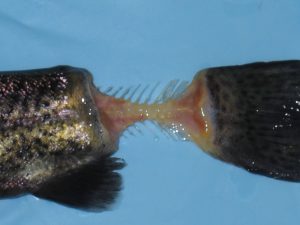Dr Thomas Loch of the Aquatic Animal Health Laboratory, led by Dr. Mohamed Faisal, is investigating the diversity of fish-pathogenic flavobacteria, which will help fish farm facilities better prevent the diseases they cause and control their spread within captive stocks.

Rainbow trout are an important source of animal protein for the Earth’s ever-expanding human population. A delight to the eye as well as the palate, rainbow trout is a primary aquaculture species in the US, as well as in Europe and South America. Food suppliers harvest rainbow trout directly from aquaculture facilities, which provide nutritious protein choices for supermarkets, while wild trout offer leisurely and nutritional satisfaction to game fishers.
But when the rainbow trout falls prey to bacterial disease, the colorful body for which it is named erodes into ragged wounds and ugly ulcers. Flavobacterial infections, which are a leading cause of disease among farm-raised fish, can kill up to 30 percent of affected hatchery stocks, costing farmers millions of dollars.

Now, a team of scientists at the MSU College of Veterinary Medicine have been awarded a $307,869 grant to study a group of common bacteria that threaten rainbow trout aquaculture in the US. Drs. Mohamed Faisal and Thomas Loch are investigating how fish farm facilities can prevent the spread of flavobacteria within captive stocks, especially if water quality is compromised due to overcrowding. The project aims to improve the yields of US aquaculture operations, in which flavobacteria are among the top disease-related impediments to productivity.

“Our primary goals are to clearly identify which of the ever-growing number of fish-associated flavobacterial species pose risks to rainbow trout in their early-life stages,” Dr. Loch says, “and then devise more effective ways of preventing disease outbreaks.”
Currently, antibiotics are commonly used to control flavobacteria. But recent studies, including Dr. Loch’s, have documented resistance to some of the many antibiotics approved to treat flavobacterial diseases in fish in the US. “We are trying to show that this problem is much more complex than previously known and that may be why control measures are failing,” Dr. Loch says.
The team is investigating the use of ultraviolet radiation to kill bacteria entering the facilities through the water, and will also be exploring ways to optimize fish egg disinfection methods. “These treatments may be a promising alternative to antibiotics,” Dr Loch says, “which most agree is a great thing.”
